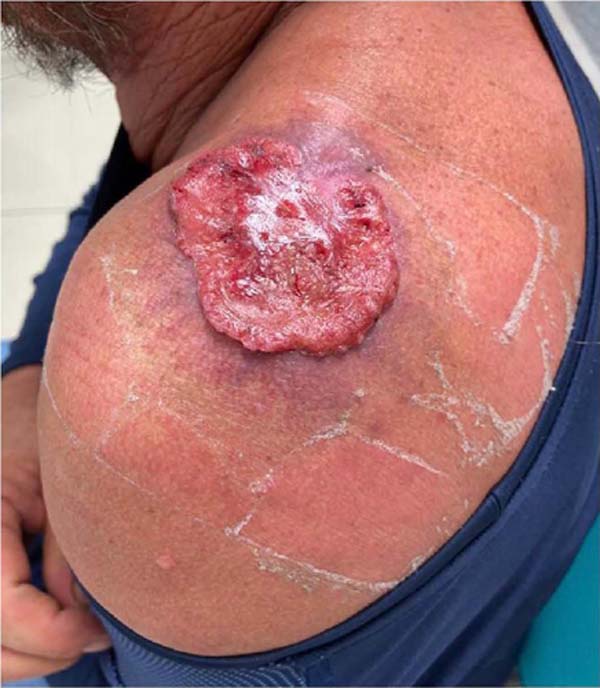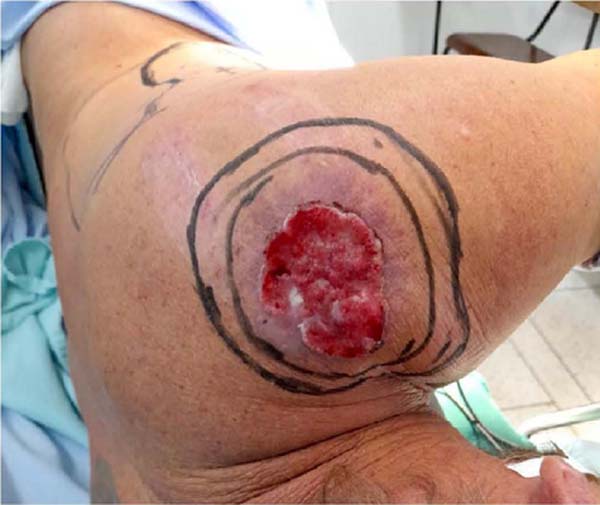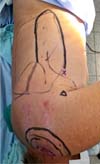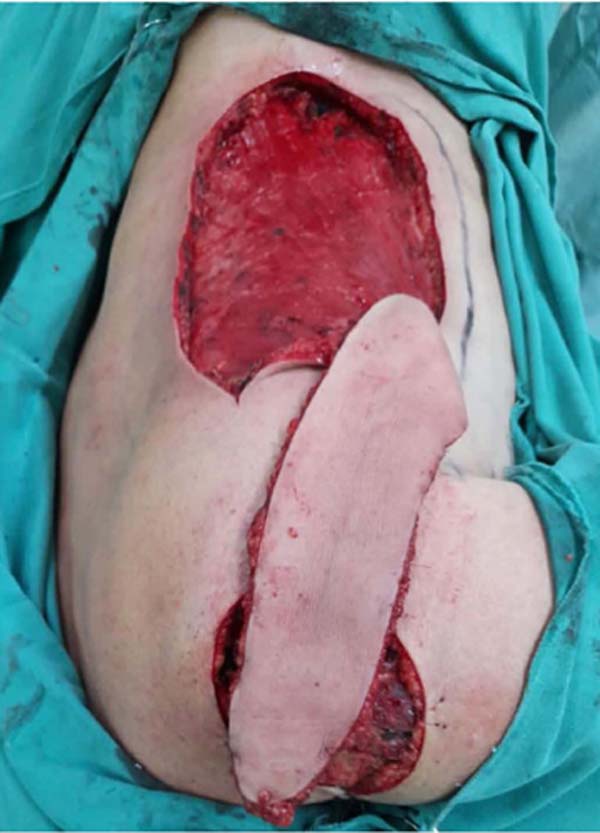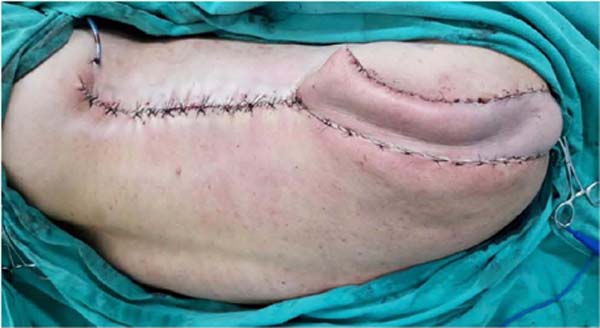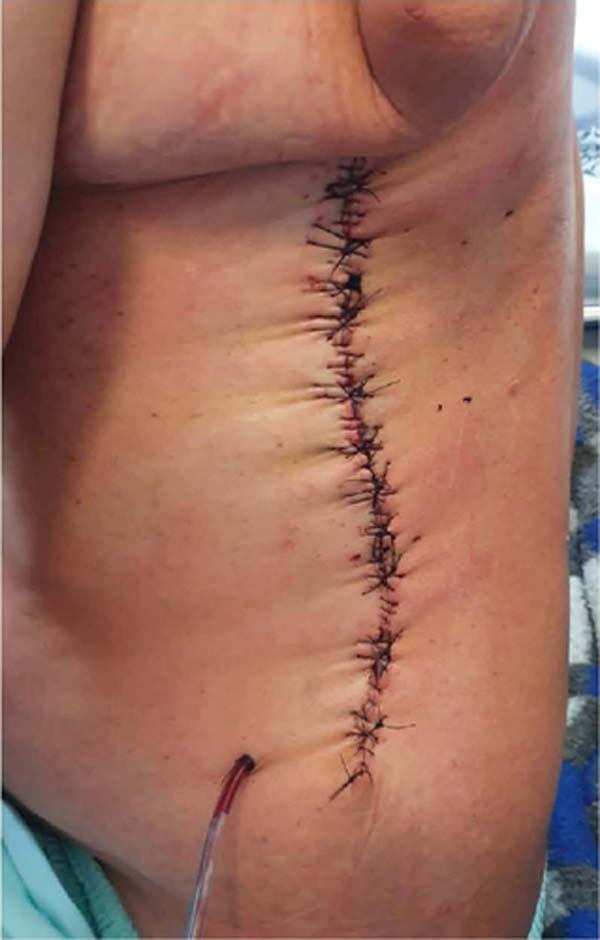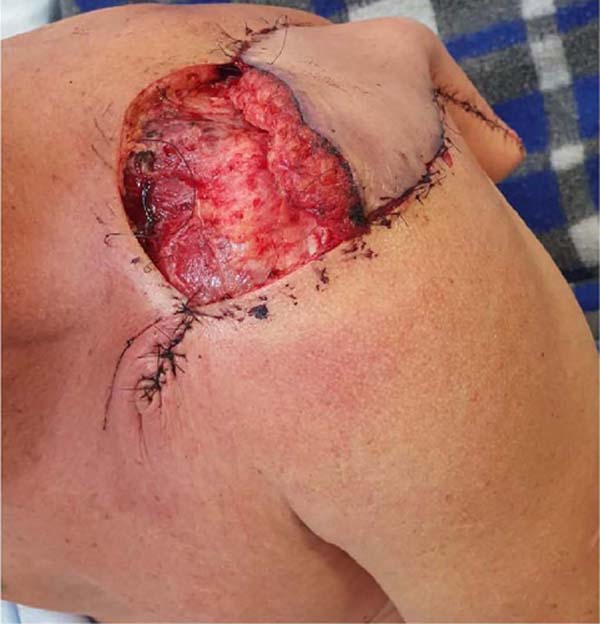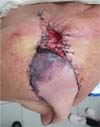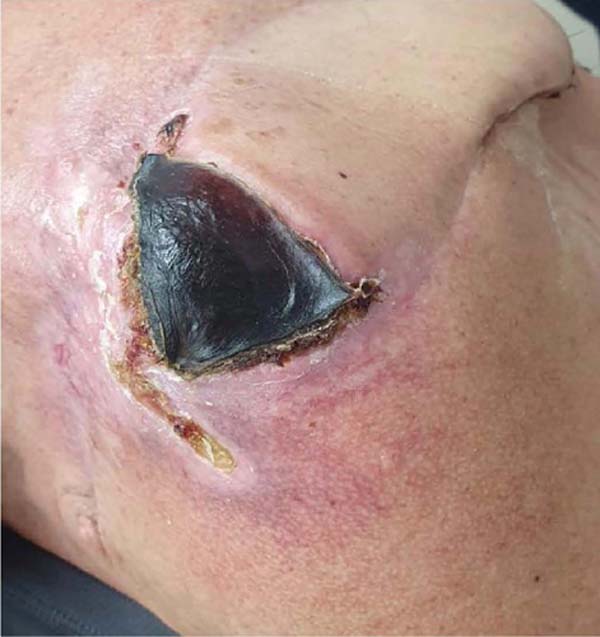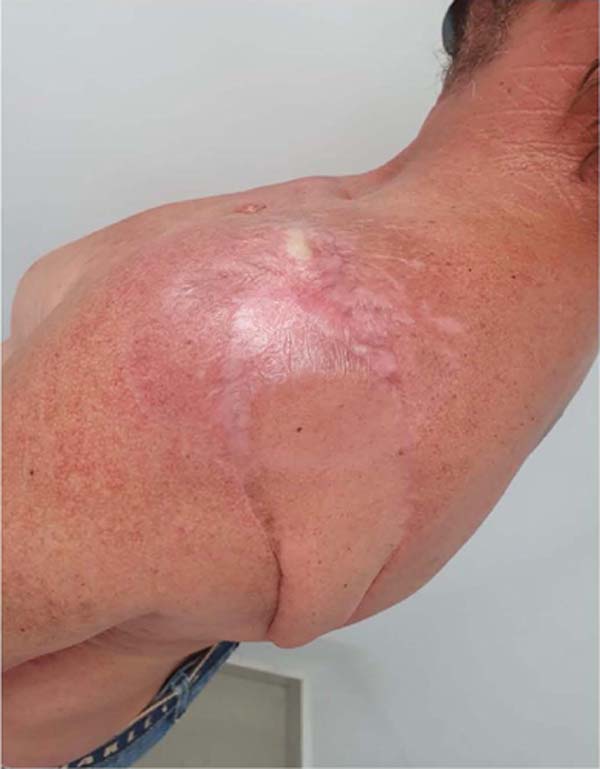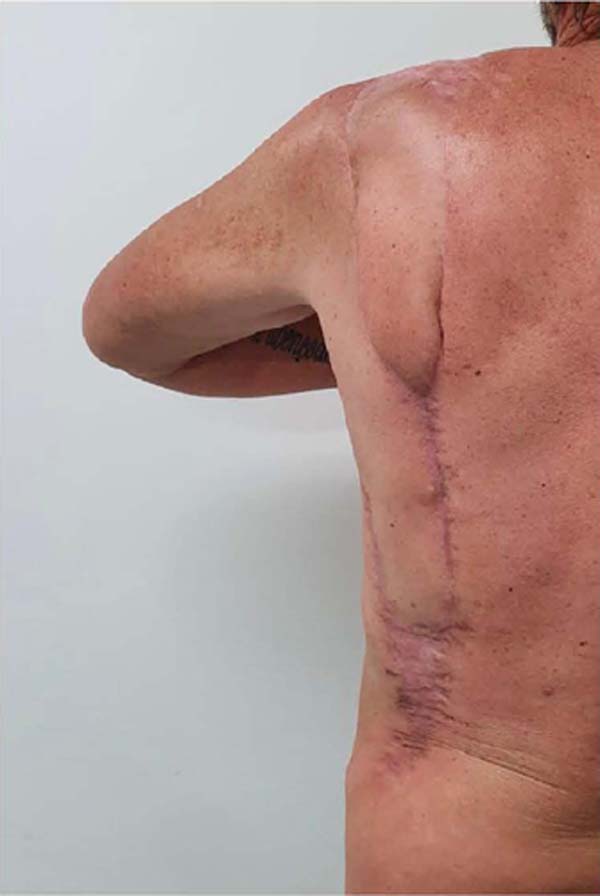INTRODUCTION
Squamous cell carcinoma (SCC) is a malignant tumor of epidermal keratinocytes
that invades the dermis and can generate metastases. It has a higher incidence
in individuals over 50 years old, with the main etiologies being: sun exposure
and carcinogenic agents1.
The most affected sites are the scalp, back of the hands, lower lip, ears, face,
buccal mucosa, and external genitalia1.
The clinical characteristics of the lesion range from erythematous papules or
plaques with a scaly or crusted surface to hyperkeratous nodules, often with a
verrucous appearance1.
A biopsy confirms the diagnosis, and the staging is performed according to the
TNM table. In addition to tumor resection, lymph node dissection and treatment
of metastases may occur, if necessary2.
This study aims to describe the suture by Góes et al.3 as a complement to the parascapular flap4, used
reconstructively after the excision of SCC.
CASE REPORT
The patient, 50 years old male, white civil construction assistant, sought care
due to an ulcerated lesion measuring 5.7 x 5.2 cm on the left shoulder, with the
appearance of SCC, confirmed by biopsy (Figure 1).
Figure 1 - Ulcerated lesion measuring 5.7 x 5.2cm.
Figure 1 - Ulcerated lesion measuring 5.7 x 5.2cm.
Preoperative tests (laboratory and cardiological) were performed, which were
normal and with surgical risk grade 1. After the demarcation of the tumor area
with oncological safety margins, the patient underwent general anesthesia and
was positioned in the right lateral decubitus position (Figure 2).
Figure 2 - Patient in surgical positioning.
Figure 2 - Patient in surgical positioning.
The lesion was resected with oncological margins and sent for anatomopathological
examination, with the result of invasive squamous cell carcinoma grade 3 of
differentiation, invasion to the subcutaneous tissue (Class V), free margins, no
angiolymphatic involvement detected, and no perineural invasion.
A parascapular flap4 was demarcated,
measuring (21cm x 6.5cm), based on the parascapular artery, a branch of the left
axillary artery (Figure 3).
Figure 3 - Demarcation of the parascapular flap.
Figure 3 - Demarcation of the parascapular flap.
The flap was elevated and rotated to reach the left shoulder region (Figures 4 and 5) and sutured to its new bed with nylon 3-0 and 4-0. This
completely covered the tumor resection area.
Figure 4 - Elevation and rotation of the parascapular flap.
Figure 4 - Elevation and rotation of the parascapular flap.
Figure 5 - Elevation and rotation of the parascapular flap.
Figure 5 - Elevation and rotation of the parascapular flap.
The donor area of the flap was repaired by advancing the local flaps and suturing
with 3-0 and 2-0 nylon (Figure 6).
Figure 6 - Donor region repair with 3-0 and 2-0 nylon.
Figure 6 - Donor region repair with 3-0 and 2-0 nylon.
After 24 hours, there was a suture dehiscence in the distal part of the flap and
pain at its extremity due to venous congestion (Figure 7).
Figure 7 - Dehiscence at the distal end of the parascapular flap.
Figure 7 - Dehiscence at the distal end of the parascapular flap.
Cyclic and continuous traction of the cutaneous margins3 was used to close the
bloody area and a small part was partially left for healing by second intention
(Figure 8).
Figure 8 - Use of the Góes Suture for partial closure of the
dehiscence.
Figure 8 - Use of the Góes Suture for partial closure of the
dehiscence.
The distal end of the parascapular flap4
with venous congestion evolved to dry necrosis of an area larger than the
initial one, which did not require debridement (Figure 9).
Figure 9 - Dry necrosis at the distal end of the parascapular flap.
Figure 9 - Dry necrosis at the distal end of the parascapular flap.
The patient was followed up, requiring radiotherapy treatment, with good
evolution and adequate surgical wound healing (Figures 10 and 11).
Figure 10 - Late postoperative after radiotherapy.
Figure 10 - Late postoperative after radiotherapy.
Figure 11 - Late postoperative after radiotherapy.
Figure 11 - Late postoperative after radiotherapy.
DISCUSSION
The literature cites numerous methods for covering the reported defect, including
skin graft5, latissimus dorsi myocutaneous
flap6, trapezius myocutaneous
flap7, and microsurgical flaps8. The preference for the parascapular
flap4 is due to its greater ability to
cover large areas, in addition to muscle preservation compared to other
myocutaneous flaps, which generate great functional loss, requiring long periods
for compensation, as is the case with the latissimus dorsi6 and trapezium flaps7.
Treatment with microsurgery8 is highly
specialized, and our Service does not have the proper equipment, so we cannot
perform it.
Due to the patient’s profession (civil construction assistant), the skin
graft5 would inevitably suffer loss
with the work activity, causing a poor prognosis.
The parascapular flap4 is described in the
literature with a length of up to 30 cm. Considering the patient’s height of
1.82m, the length of the flap was adequate for its use, with the advantage of
ensuring thick coverage - resistant to trauma and without muscle mobilization,
allowing the patient to return to activities early.
Wound closure by skin traction, recommended in 2004 by Carlos Henrique Fröner S.
Góes et al.3, was performed in the ward on
the second postoperative day to correct the dehiscence. For this purpose,
Prolene 2 thread was used, with insertion in the area posterior to the
detachment, exteriorizing it inside the wound, towards the other margin, and the
thread is wrapped through the needle with a catheter segment. A “U” was
completed bilaterally by returning the thread in reverse. The two threads on
each side were pulled simultaneously, bringing the edges together with a certain
point of maximum tension. Through repeated traction, greater skin relaxation and
the possibility of partial closure were promoted. This avoided performing a new
procedure in a surgical center, which would cause great emotional stress to the
patient and higher costs to the institution that maintains it.
The suture proved an efficient method, promoting partial closure of the defect
(80% of the dehiscence area), ease, and reduced time to perform in addition to
one-time residual defect correction.
CONCLUSION
The suture proposed by Góes et al.3 proved
to complement the parascapular flap4 in
covering the resection of large tumor areas, with the advantages of being
low-cost and easy to perform. In addition, skin traction provided satisfactory
correction of large postoperative dehiscence using a parascapular flap4.
1. Hospital de Câncer de Campo Grande Alfredo
Abrão, Campo Grande, MS, Brazil
2. Universidade Federal de Mato Grosso do Sul,
Campo Grande, MS, Brazil
3. Associação Beneficente Santa Casa de Campo
Grande, Campo Grande, MS, Brazil
4. Universidade Estadual de Mato Grosso do Sul,
Campo Grande, MS, Brazil
Corresponding author: Franco Silva
Martinez Rua Petrópolis, 585, Caiçara, Campo Grande, MS, Brazil Zip
Code: 79090-234 E-mail: francosmartinez99@gmail.com



